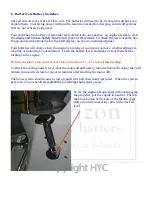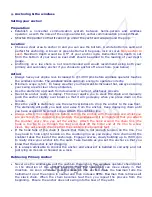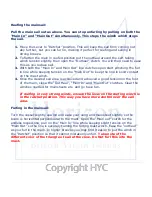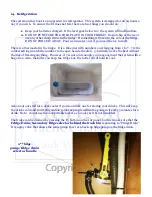
9.
Anchoring & the windlass
Setting your anchor:
Preparation:
•
Establish a nonverbal communication system between helms-person and windlass
operator, as with the noise of the engine and wind, verbal communication proves difficult.
•
Shorten the painter so that it cannot go under the yacht and wrap around the prop.
Location:
•
Choose a clear area to anchor in and you can see the bottom. A white bottom is sand and
perfect for anchoring. A brown or green bottom will be grass, rock or coral.
Only anchor in
sand
. Maximum depth would be 1/5
th
of your anchor rode. Remember the depth is set
from the bottom of your keel so keel draft should be added to the reading of your depth
gauge.
•
Anchoring on a lee shore is not recommended and would recommend using both your
primary and secondary anchor if you choose to anchor off a lee shore. (see below)
Action:
•
Always have your engine revs increased to @ 1400 rpms before windlass operator touches
the windlass remote. The windlass needs optimum energy to operate correctly.
•
Minimum scope is 5:1. In heavy weather you may want to increase that, always ensuring
your swing area is clear of any obstacles.
•
Use the elements; approach from downwind or current, whichever prevails.
•
Have the anchor ready to deploy. This may require you to slack the chain and manually
push the anchor slightly over board so that it will go deploy when you press down on the
remote.
•
Once the yacht is stationary use the electric windlass to drop the anchor to the sea floor.
The elements will push you back and away from the anchor. Keep deploying chain until
you have acquired the correct scope. Attach the snubbing line.
•
Always attach the snubbing line before setting the anchor with the engine and whilst you
are anchored. The snubbing line protects the windlass and it is important that you attach
the snubber every time you set the anchor.
Attach the hook around the chain link (the
hook is too big to go through the link) and cleat off the bitter end of the line to a bow
cleat. Pay out enough chain so that the snubbing line becomes taut.
•
If the hook falls of the chain it means that there is not enough tension on the line. You
may need to hold slight tension on the snubbing line as you deploy more chain until the
snubber takes the load of the anchorage. Engage reverse, slowly building up to 1500 rpm
to really drive your anchor into the sand. Take transits as you set the anchor so that you
know that the anchor is not dragging.
•
It is always advisable to snorkel the anchor and ensure it is bedded in correctly and not
just lying on its side or hooked on a rock.
Retrieving Primary Anchor:
•
Never use the windlass to pull the yacht to the anchor. The windlass operator should point
in the direction of the anchor chain so that the helmsman can move slowly in that
direction. As soon as there is some slack on the anchor chain the bowman tells the
helmsman to put the engine in neutral and then increase RPMs. Bowman then retrieves all
the slack chain. When the chain becomes taut then you repeat the process from the
beginning. Ensure the anchor does not swing into the bow of the yacht.
Содержание Bavaria 32 2012
Страница 1: ...Information operations manual for Bavaria 32 2012...
Страница 4: ......
















































